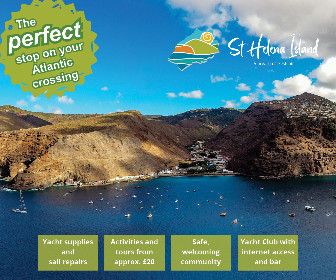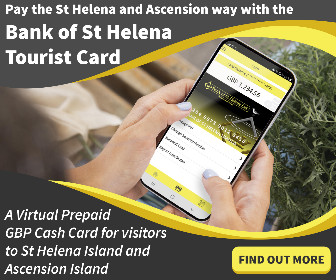Indian Ocean Voyage Part 4: Cruising South African Waters
After 42 days at sea and over 7000 miles across the Indian Ocean, SY Zoonie arrived in Richards Bay, South Africa. This is part 4 of their Indian Ocean series, this time covering their voyage around the South Africa coast.
Published 3 years ago

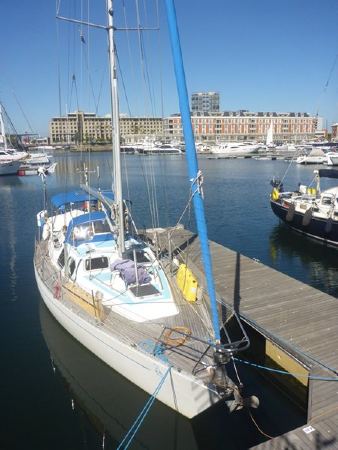
- Zoonie docked after the Indian Ocean passage.
Resting in Richards Bay
The same day that we arrived in Richards Bay after crossing the Indian Ocean, we had our Covid tests. Thankfully, they came back negative on Tuesday and then the wait for Immigration started. Finally on Thursday after a wasted journey to their office a charming officer came to the dock and under one of the sun umbrellas at Dros Restaurant we all cleared in and immediately moved on to the Zululand Yacht Club for a delightful five week stay.
Annelie (072 527 0194) took us in her car/taxi to customs for the final clearing requirement and then on to a mall for some fresh fruit and veg and safari clothes. The next day she took us to the airport to collect a hire car for the week and then it was off to the dentist, followed by Zoonie’s fuel run with the 8 x 20 litre cans.
Richards Bay is very close to lots of safaris and we spent a magical four days at the Rhino River Lodge.
Over the Sand Bar and On to Durban
The birds were still in vocal form and it was before 5.00am when we took Zoonie’s lines aboard and cleared the sand bar by two metres for the 90-mile journey to Durban. There was no usable wind but we did have a favourable tide of half a knot as we headed between the big ships in the anchorage towards the 200-metre contour that was supposed to contain some Agulhas Current to help us on our way.
The day went by very quickly but we knew we were in for a night time approach to Durban. No worries, it is a busy shipping port so everything will be well lit up. Eight ships rested at anchor awaiting their turn rolling gently in the slight sea.
We hadn’t been expecting the beautiful sunset that cast the city skyline into silhouette. The fairway buoy came up as it should and after a call to Port Control on VHF CH 9 we furled the genoa and headed for the channel marker red and green lights. Rob took us cautiously towards the yacht dock where a marina guard helped us to moor up just a few metres from the shore and a concrete slipway. Moments later the Port Police arrived by boat and when they were satisfied a lady from ‘health’ was brought along by a security guard. Using a torch she looked at our papers and Covid results forms and said we must wait aboard until a doctor would come down the next day to do our Covid Tests, which we would have to pay for, as the first ones were five weeks old.

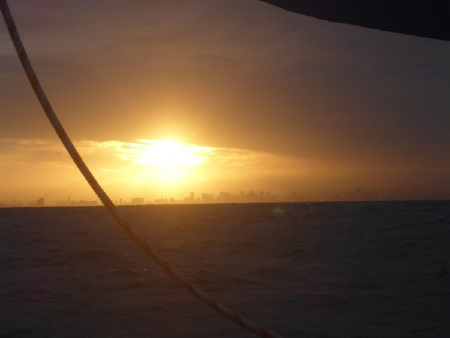
- Sunset over Durban
Late afternoon the next day Rob phoned the Durban Marina Office who said we didn’t need a Covid test and should mosey up to the office for some more form filling. We again asked to be ‘allowed’ to plug in to the nearest electrical point. We came away with no satisfactory reason as to why we couldn’t, considering there were numerous points nearby.
Tracey in the office strongly advised we should not stray far from the marina because of lack of security and the Covid risk, she also said all the tourist attractions were now closed anyway.
A Walk in the Park
The prospect of another week in Durban, floating with the decaying rubbish in the marina and unable to even think of going for a short walk was playing on my mind so I looked once again at Windy, our weather app and saw to my relief that the weather window that we thought had disappeared was back and indeed, it looked good.
“A Walk in the Park” is how Des Carson (our trusty weather guru from our Indian Ocean crossing) described the next two days down to East London, so we were back up to the office to complete our flight plan as quick as couple of squirrels with their tails on fire. Departure time was set at 5.00am the next morning.
After seven hours we were motoring along just over five miles offshore where Des said we would find the elusive Agulhas and suddenly noticed the gentle hand underneath us start pushing us up by first 2.5 knots and then up to three knots over our boat speed. The engine went off and with her poled out genoa full, Zoonie entered the night at 8.4knots of delicious speed. We had thought the journey of 250 miles would take 48 hours, two nights at sea, but not if this wonderful ocean gift stayed with us.

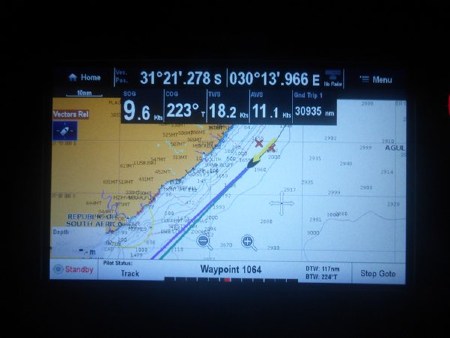
- Helping hand from the Agulhas Current.
“Remember to turn for the harbour entrance when you get to Cape Morgan, 40 miles north of East London or you will be set on past.” Des’s words.
Don’t get me wrong this is a tricky section of the South Africa east coast and has claimed many an experienced sailor but we take as we find having started out with due care and forethought and this is how it was for us.
Zoonie adopted a languid, gentle roll, the waves created the music and the wind sighed as it pushed us along and with the guiding hand beneath giving us four knots we were at times doing 10 knots over the ground.
By the next morning Rob was feeling rough, our rusty throats seemed to be developing into something, could it be Covid after our 100% precautions of closely fitting four layered masks, repeated hand sanitising and keeping well apart?
Our second day was ageing and I took Rob’s temperature to discover it was 38.8; thank goodness we had only 20 miles to go.
East London and more COVID tests
When just off the mouth of East London I called up the Port Authority VHF CH 16 or 12 and explained our situation. The officer instructed us to stay outside until he had spoken to Port Health and naturally when they came back it was assumed we carried the Virus. We were allowed to motor up the river to the mid-river mooring trots and tie up remaining on board until a test could be arranged the next day.

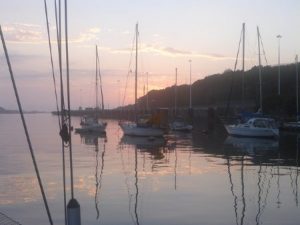
- Sunrise while under quarantine in East London.
Our location off Buffalo River Yacht Club was delightful, surrounded by a diversity of water birds with steep, wooded banks on either side and two bridges ahead of us, so we have plenty to watch.
The next morning Charles who runs a local shipping supply business and is a very useful agent for cruisers, (+27 83 652 0729) organised a Covid test, the Port Quarantine Officer phoned to see if there was anything he could do to help and Conrad from the Buffalo River Yacht Club was ready on hand if we needed him.
We inflated the tender and Rob rowed us ashore for our tests.
It was reassuring, the fact that our little support group came together so quickly. Conrad and his little daughter, Willow, rowed out to us in a rickety tender with the drugs and a bag of goodies courtesy of the Yacht Club which is usually a bustling place.
Getting Better in Buffalo River
The birds are increasingly happy with us here. The terns preen themselves on our handrails, a wagtail tries to come in and say ‘hi’, and this morning a goose was standing on the cockpit coaming wondering when I was going to get up!

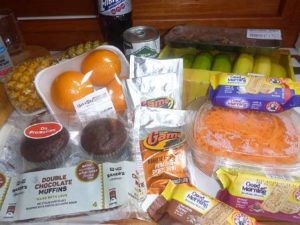
- Gift box from Conrad at the Buffalo River Yacht Club.
We relished the food bag that Conrad brought along and the juicy Queen Pineapples were delicious. It isn’t hard in South Africa to maintain Vitamin C levels with their delicious Pineapples, plums, nectarines, peaches, blueberries and bananas.
“The only way we knew you were still alive was when you hung the washing out!”
Conrad told Rob when he was ashore after our quarantine ended on one of our ‘get fit and filled up’ water runs. He and his daughters Anna and Willow took us up to the local SuperSpar so we could shop while they did the same.
Des emailed and pointed out the 24 hour window starting the next day, which would let us move on to Port Elizabeth, 130 miles south from East London.
So we filed our flight plan with Conrad and John at Port Elizabeth and he sent it to the Port Authority at Buffalo River and at Port Elizabeth. These flight plans may seem tedious to some but they are to give the rescue authorities an immediate identification of any craft that is in trouble and needs rescuing on this wild stretch of coastline. Besides they seem to get simpler to fill in the further we went.

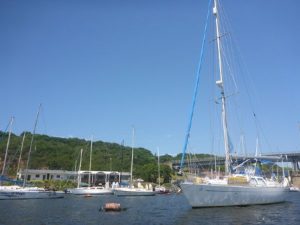
- Zoonie in front of the Buffalo River Yacht Club.
The Leaving of Buffalo River
The river water was like a mirror as I disturbed the peace by starting the engine at 5.15 on the 28th January. We tied together the mooring lines and dropped them over the side as I motored us slowly away from our place we had occupied for 19 days and for which Conrad made us no charge, “You weren’t here for pleasure exactly were you.”
The day was going to be a beauty as Zoonie nosed into an 11 knot headwind and we soon picked up 2.2 knots of our old friend the Agulhas Current. We hurried south south west, keen to reduce the miles to when we would turn westwards out of the Indian Ocean and looking to the shore we watched as the distant feint rolling hills advanced to stands of dark green woodland above golden sand dunes for miles and miles along the coast.

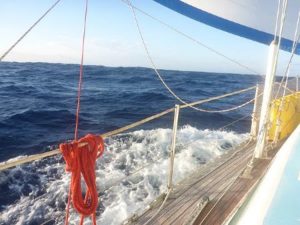
- Fine sailing down the coast of South Africa.
By 1700 we were losing the current but with the sea being undisturbed by any wind, just the gentle roll and swell from the Southern Ocean, Zoonie was unhindered in her progress. It was as calm as a Southern Ocean swell could be.
Through the night we could see the lights of Port Elizabeth spreading around Algoa Bay and an acrid smell permeated our nostrils and bit into the walls of our throats. It was ore based but not like the smell of coal dust or iron ore. It turned out to be Manganese dust blowing our way from where a ship was being loaded as and when the horn blowing trains arrived from the mines.
Early morning into Port Elizabeth
We found our way into Port Elizabeth having received permission from the Port Authority on CH 12 and moored in Algoa Marina at 3.48 in the morning.
John Trudehope , the OCC Port Officer had informed Port Control of our situation – Covid survivors on route to Cape Town, so there was no delay there, we had done our time. We dozed off to the sounds of frapping halyards, police sirens and Zoonie’s squeaking lines.
For the second time we thought our weather window would be at least a week away but suddenly realised we had one in just three days, which as I suggested to Des could take us right around to Cape Town. It was certainly proving true that conditions for heading west around South Africa improve as the summer matures. So just a long weekend in Port Elizabeth it would be.
John came early the next morning, after the curfew ended. He has a very nice racing cruiser moored a few fingers from us and he let us borrow his vehicle so we could refuel at the nearby petrol station and do a shop at the Superspar just behind it, all while he was out sailing.

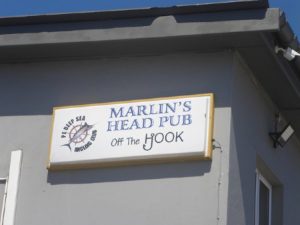
- A great watering hole in Port Elizabeth.
The Deep Sea Fishing Club is home to the Marlin’s Head Pub off the Hook bar and restaurant with its expansive views over the marina, fishing fleet and docks, where we had a good two course meal for just 7 pounds each. They did a brilliant job of making non-alcoholic drinks seem as attractive as their more mature counterparts.
The motion in the harbour was interesting. Zoonie jostled and snatched at her mooring lines, the swell reaching as far as our otherwise sheltered location. Long term residents had many lines securing them to their berths, some even had stainless steel springs around their lines to act as shock absorbers.
Our ETD moved backwards for Monday from 18.00 to midday and we slipped lines at 11.30am.
Where Two Oceans Meet
We were only at sea for a few minutes, out of Port Elizabeth on another sunny day when we passed seven Jackass Penguins swimming in a closely huddled group. There wasn’t much wind but Rob poled out the genoa and with that sail pulling and the Agulhas Current helping, as soon as we left port we managed a respectable 5.3 knots with the engine turned off.
Our weather window was holding and appeared to extend for at least a week from the first of February, the day we left, the longest we had seen yet.
We had been warned about the numerous ships we would come across on this busy route around the Capes and soon we were caught up in the crowd coming towards us and diverging around us as they approached from behind. Then there were the fishing boats, oblivious to everything except their task in hand.

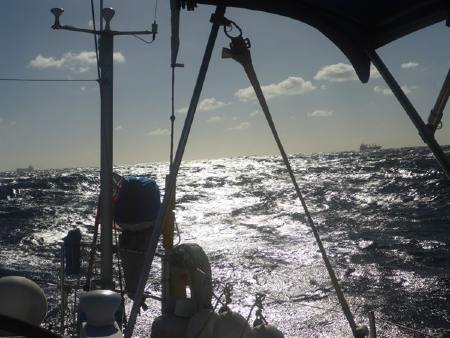
- Ships diverging for Zoonie.
For the first time ever a ship actually called us and the officer explained the action he was going to take to pass down our starboard side as he overtook. Impressive; both considerate and professional.
At midday on the second day and date we turned west for Cape Town 281 miles away and we knew we were in for a blow, just hoping we would be able to make use of it.
Time came to slide the main into the mast because its role as a steadying sail was being challenged by the building sea which, in advance of the blow that was coming, threatened to push her sideways and we didn’t want that.
The risk of a broach eliminated we all felt more comfortable, Zoonie included and the genoa was free to do its job of pulling us along.
At 01.38 in the night the wind was rising and the sea was in the same mood and within a few hours Zoonie was belting along with a reefed headsail in winds between 22 and 29 knots, relishing the freedom to do 8 knots at times without need of the engine. This blissful boost lasted fifteen hours.

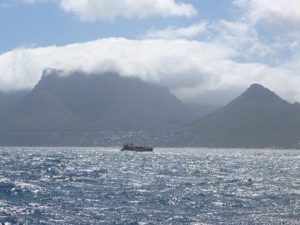
- Passing a fishing boat loaded with craypots approaching Cape Town.
Suddenly, as daylight arrived, we were passing pairs of big pink buoys in a line at 50 metre intervals no more than 15 metres from us. A deadly drift net, harbinger of death to marine life whether suited in scales or feathers and deadly for us had we got caught up in it and even worse if our engine had been on. In the night you just cannot see them.
The beautiful Agulhas Current was still with us.
The night after the blessed wind left us was damp; everything in the cockpit shone with moisture under silver moonlight. Droplets clung on to the underside of the bimini; we could feel the chill damp on our skin and everything below soaked up some of the moisture. We were in the area where two oceans meet. Leaving behind us the temperamental Indian Ocean with the Atlantic ahead; our home ocean.

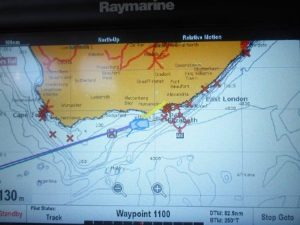
- Heading for Cape Town.
Des suggested we head for the gap between the Six Mile Bank and the Twelve Mile Bank, where the majority of the ships go. Ooh that could be a squeeze I thought.
A baby buster was expected off Cape Agulhas tomorrow, the most southerly cape of the continent, so we were hoping we would have made the turn north before then and receive it as a beam wind boosting us on.
The third day and date dawned cloudless again but with little wind, so the iron topsail was full and pulling.
A seal arched out of the water to see us, all of 20 miles offshore and a juvenile yellow nosed albatross came to take a look at us
At 13.50 we sighted Cape Agulhas 20 miles away; would we lose the current there we wondered?
Melting ice cube clouds spotted the sky at low level and the Cape of Good Hope was not far away, around the corner.
The ships were now heading directly for the west bound separation lane to the north of the Agulhas Gas Field, the oncoming ships in the eastbound lane to the south of the field. So we drew a course just out of the westbound lane and felt a lot more comfortable.
We passed The Cape of Good Hope in my 4 am to 7 am watch, its bright white flashing light the only sparkle in an otherwise ceiling to floor grey. But soon the blue sky grew with the morning and as you can see and as Des told us, the beautiful scenery is there to be enjoyed.

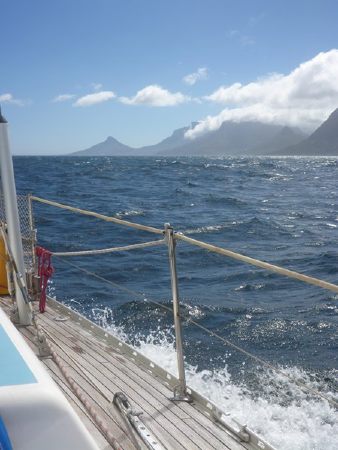
- Dramatic views approaching Cape Town.
Between a rock and hard place, literally, we made a course 3 miles from the shore, mostly on the 200 metre contour to avoid the craypots laid on the rocks just off the coastline and not so far out to cause a nuisance to the ships.
Zoonie was cruising gently along under poled out genoa, the engine off briefly.
As we approached where the skyscrapers sat on the headland and we were passing houses creeping from the shore up the mountain slopes we knew this testing trip was nearly over.

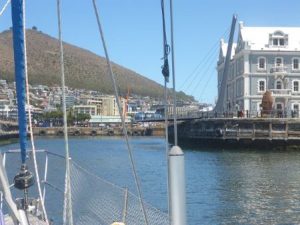
- The swing bridge opened for us on entry to Cape Town.
We had given Peter Sherlock of the Royal Cape Yacht Club plenty of notice we were on our way. Peter liaises with yacht clubs all around the SA coast to ensure smooth arrivals in SA for the likes of us.
Two bridges (VHF CH 71 or +27 021 408 7700) opened to allow us into the inner lagoon of the V&A Marina (VHF CH 14, +27 021 4087579) right in the city centre and Janneke and Weitz and a marina attendant took our lines at 13.00hrs on the 4th Feb. We had arrived and are now in our last ocean, free to head north, eventually.
Clearing in to Cape Town
Even though we officially cleared in to South Africa in Richards Bay in November 2020, we had to follow another process in Cape Town which involves collecting letters from the Royal Cape Yacht Club and the Port Control Office atop the Control Tower.
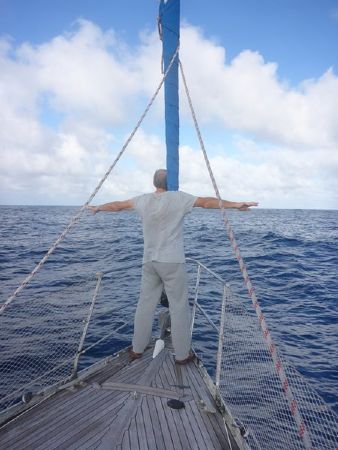

With the help of a Bolt car (like Uber) the process was all easy and pleasant especially taking photos of the views over the harbour from the top of the control tower, of the route we had taken in to the V&A Marina through the outer and inner harbour. The final visit was to the Immigration and Customs office on Old Duncan Dock where they set up a file for us to make clearing out, in the same order of YC Port Control and Immigration, a straightforward process.
Barb and Rob White
SY Zoonie (UK)
http://blog.mailasail.com/zoonie
Helpful Contacts
Jenny Crickmore-Thomson is an essential contact for a smooth arrival in South Africa; (+27 72 106 3936, [email protected])
Des Carson – our trusty Weather Guru – [email protected]
Zululand Yacht Club (+27 (35) 788 0256)
Durban Marina Office (031 301 2176)
Buffalo River Yacht Club – Contact Conrad Bennett +27 633 097913 in advance
Port Elizabeth – The OCC Port Officer is John Trudehope 0828543961 [email protected].
Royal Cape Yacht Club, Cape Town: Contact Peter Sherlock +27 824 71423 [email protected]
………………………………………………………………………………………………………………………………………
Related Reports:
- Indian Ocean Voyage Part 1: Taking the Southern Route across The Australian Bight
- Indian Ocean Voyage Part 2: From Fremantle, Australia to La Reunion
- Indian Ocean Voyage Part 3: La Reunion to South Africa
- Madagascar and Mozambique Channel – by Des Cason (January 2021)
- Other Indian Ocean Reports
………………………………………………………………………………………………………………………………………
The opinions expressed in this article are the author’s own and do not reflect the view of Noonsite.com or World Cruising Club.
Related to following destinations: Cape Town (Table Bay), Durban, East London, Port Elizabeth, Richards Bay, South Africa
Related to the following Cruising Resources: Circumnavigation, Indian Ocean, Routing

